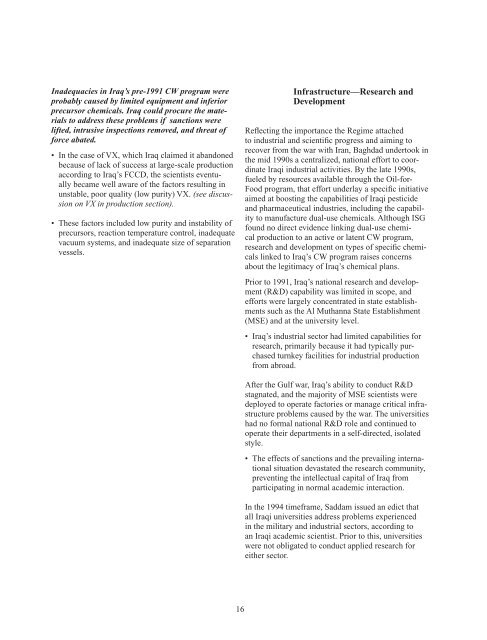Comprehensive Report
GPO-DUELFERREPORT-3
GPO-DUELFERREPORT-3
- No tags were found...
You also want an ePaper? Increase the reach of your titles
YUMPU automatically turns print PDFs into web optimized ePapers that Google loves.
Inadequacies in Iraq’s pre-1991 CW program were<br />
probably caused by limited equipment and inferior<br />
precursor chemicals. Iraq could procure the materials<br />
to address these problems if sanctions were<br />
lifted, intrusive inspections removed, and threat of<br />
force abated.<br />
• In the case of VX, which Iraq claimed it abandoned<br />
because of lack of success at large-scale production<br />
according to Iraq’s FCCD, the scientists eventually<br />
became well aware of the factors resulting in<br />
unstable, poor quality (low purity) VX. (see discussion<br />
on VX in production section).<br />
• These factors included low purity and instability of<br />
precursors, reaction temperature control, inadequate<br />
vacuum systems, and inadequate size of separation<br />
vessels.<br />
Infrastructure—Research and<br />
Development<br />
Reflecting the importance the Regime attached<br />
to industrial and scientific progress and aiming to<br />
recover from the war with Iran, Baghdad undertook in<br />
the mid 1990s a centralized, national effort to coordinate<br />
Iraqi industrial activities. By the late 1990s,<br />
fueled by resources available through the Oil-for-<br />
Food program, that effort underlay a specific initiative<br />
aimed at boosting the capabilities of Iraqi pesticide<br />
and pharmaceutical industries, including the capability<br />
to manufacture dual-use chemicals. Although ISG<br />
found no direct evidence linking dual-use chemical<br />
production to an active or latent CW program,<br />
research and development on types of specific chemicals<br />
linked to Iraq’s CW program raises concerns<br />
about the legitimacy of Iraq’s chemical plans.<br />
Prior to 1991, Iraq’s national research and development<br />
(R&D) capability was limited in scope, and<br />
efforts were largely concentrated in state establishments<br />
such as the Al Muthanna State Establishment<br />
(MSE) and at the university level.<br />
• Iraq’s industrial sector had limited capabilities for<br />
research, primarily because it had typically purchased<br />
turnkey facilities for industrial production<br />
from abroad.<br />
After the Gulf war, Iraq’s ability to conduct R&D<br />
stagnated, and the majority of MSE scientists were<br />
deployed to operate factories or manage critical infrastructure<br />
problems caused by the war. The universities<br />
had no formal national R&D role and continued to<br />
operate their departments in a self-directed, isolated<br />
style.<br />
• The effects of sanctions and the prevailing international<br />
situation devastated the research community,<br />
preventing the intellectual capital of Iraq from<br />
participating in normal academic interaction.<br />
In the 1994 timeframe, Saddam issued an edict that<br />
all Iraqi universities address problems experienced<br />
in the military and industrial sectors, according to<br />
an Iraqi academic scientist. Prior to this, universities<br />
were not obligated to conduct applied research for<br />
either sector.<br />
16


